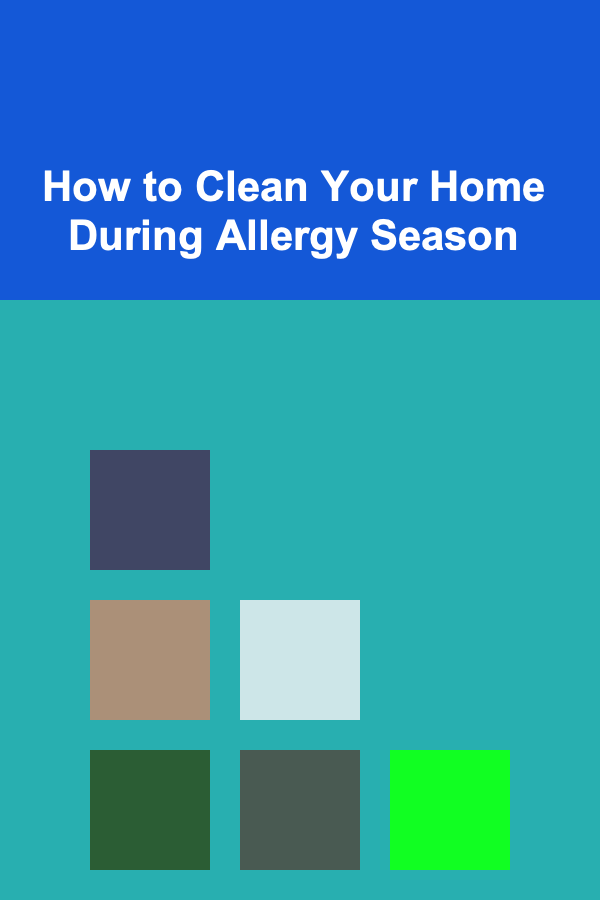
How to Clean Your Home During Allergy Season
ebook include PDF & Audio bundle (Micro Guide)
$12.99$9.99
Limited Time Offer! Order within the next:

Allergy season can be an incredibly difficult time for those who suffer from seasonal allergies. As the weather changes, pollen, dust, and other allergens fill the air, triggering symptoms such as sneezing, congestion, itchy eyes, and a runny nose. While it's impossible to completely eliminate allergens from your environment, one of the most effective ways to minimize exposure and relieve symptoms is through deep cleaning your home.
A thorough cleaning regimen tailored to tackle allergens can make a significant difference. In this article, we will explore various strategies for cleaning your home during allergy season, covering areas such as air quality, floors, bedding, furniture, and even pet care, all of which play a crucial role in allergy management. By following these steps, you can reduce allergens, improve your living environment, and minimize allergy flare-ups.
Understanding Allergens and Their Impact
Before delving into cleaning methods, it's important to understand what allergens are and how they affect individuals with allergies. Allergens are substances that can trigger allergic reactions. Common indoor allergens include:
- Pollen: This is one of the most prevalent allergens during allergy season, especially during spring when trees, grass, and flowers release pollen into the air.
- Dust Mites: These microscopic organisms thrive in warm, humid environments and are commonly found in bedding, upholstered furniture, and carpets.
- Mold: Mold spores are present in areas with excess moisture and can cause severe allergic reactions, especially in bathrooms, basements, or areas with water leaks.
- Pet Dander: Pets, especially cats and dogs, shed skin flakes and hair that can trigger allergic reactions in sensitive individuals.
- Cockroach Droppings: Although not as commonly thought of, cockroach droppings can be a potent allergen, particularly in older buildings.
To effectively reduce the impact of these allergens, it's crucial to target specific areas of your home where these irritants are most likely to accumulate.
Step 1: Improve Air Quality
One of the first things to focus on during allergy season is the air quality inside your home. Allergens often become airborne, which makes them easier to inhale. By improving your indoor air quality, you can reduce the concentration of these particles in your environment.
Use Air Purifiers
Air purifiers with HEPA (High-Efficiency Particulate Air) filters are excellent at capturing tiny particles like pollen, dust, and pet dander from the air. Place air purifiers in key rooms, especially in the bedroom, where you spend a significant amount of time. Make sure to choose an air purifier with a HEPA filter, as these are designed to trap airborne allergens effectively.
Keep Windows Closed
During allergy season, it's a good idea to keep windows closed, especially when pollen counts are high. Opening windows can let allergens enter your home and worsen your symptoms. If you need fresh air, consider using an air conditioning system with a clean filter that circulates air without letting in outdoor allergens.
Change Your HVAC Filters
If your home has a central heating and cooling system, changing the filters regularly is essential during allergy season. HVAC filters trap airborne particles, but over time, they can become clogged and less effective. Opt for a high-quality filter designed to capture smaller particles, such as HEPA or MERV (Minimum Efficiency Reporting Value) rated filters. Change the filter every 1-3 months during allergy season for optimal performance.
Use Dehumidifiers
Humidity promotes the growth of mold and dust mites, both of which are common allergens. Dehumidifiers help reduce indoor humidity levels, making your home less inviting for these pests. Aim for a humidity level of around 30-50% to reduce the chances of mold and dust mite growth.
Step 2: Focus on Floors and Carpets
Carpets, rugs, and other floor coverings are notorious for trapping allergens such as dust, pollen, pet dander, and mold spores. Regularly cleaning and maintaining these surfaces is essential to reduce allergens in your home.
Vacuum Regularly with a HEPA Filter
Vacuuming is one of the most important steps in reducing allergens, but not all vacuums are equal. For maximum allergen removal, use a vacuum cleaner equipped with a HEPA filter. HEPA vacuums are designed to trap tiny particles and prevent them from being released back into the air. Vacuum your floors, rugs, and carpets at least twice a week during allergy season. Pay special attention to high-traffic areas, as they accumulate more dirt and dust.
Steam Clean Carpets and Rugs
Steam cleaning is an effective way to deep clean carpets and rugs. The high temperatures of the steam kill dust mites and remove allergens trapped deep within the fibers of the carpet. If you have pets or small children who are more sensitive to allergens, consider steam cleaning your carpets and rugs once every 2-3 months. You can either rent a steam cleaner or hire a professional carpet cleaning service.
Wash Area Rugs and Mats
Area rugs and mats should be washed regularly, as they can harbor allergens just like carpets. Wash smaller rugs in hot water to kill dust mites and remove pollen or pet dander. For larger rugs, consider professional cleaning if they cannot be washed in a machine.
Use Hard Flooring Where Possible
If you're in the process of remodeling or redecorating your home, consider switching to hard flooring materials such as wood, tile, or vinyl. These surfaces are much easier to clean and don't trap allergens as carpets do. While hard floors still need regular cleaning, they're a more allergy-friendly option in the long term.
Step 3: Clean Bedding and Upholstered Furniture
Your bedroom and living room furniture, including bedding, cushions, and upholstered sofas, can accumulate dust mites, pet dander, and pollen. Cleaning these surfaces is essential to reduce allergens in the air.
Wash Bedding Weekly
Your bed is one of the most common places where dust mites accumulate. Wash your sheets, pillowcases, blankets, and comforters in hot water at least once a week during allergy season. Use a hot wash cycle of at least 130°F (54°C) to effectively kill dust mites. If you can, consider using allergen-proof pillow and mattress covers to create a barrier between you and the allergens trapped in your bedding.
Vacuum Upholstered Furniture
Upholstered furniture can be a breeding ground for dust mites, pet dander, and pollen. Use a vacuum cleaner with a HEPA filter to clean sofas, chairs, and other upholstered pieces regularly. Pay special attention to the seams, cushions, and any crevices where dust and allergens might accumulate. For a more thorough cleaning, consider using a fabric-safe upholstery cleaner or having the furniture professionally cleaned.
Clean Curtains and Blinds
Curtains and blinds are often overlooked when cleaning for allergens, but they can trap a significant amount of dust and pollen. Wash curtains regularly according to the manufacturer's instructions or vacuum them if they can't be washed. For blinds, use a damp cloth to wipe them down and remove accumulated dust.
Step 4: Manage Pet Allergens
For pet owners, cleaning during allergy season requires additional attention to pet-related allergens, such as dander and fur. While it's not necessary to give up your pets, managing their impact on your home can help alleviate allergy symptoms.
Bathe and Groom Pets Regularly
Regular grooming can help reduce the amount of pet dander and hair in your home. Bathe pets at least once a month (or more often for pets with longer fur) to remove dander and loose hair. Brushing pets outdoors, if possible, can prevent pet hair from accumulating inside the home. Be sure to use a pet-friendly shampoo and grooming products to avoid irritating their skin.
Keep Pets Off Furniture and Beds
Designate specific areas for your pets to sleep and relax. Keeping pets off furniture, especially beds and couches, can reduce the amount of dander and hair that accumulates on these surfaces. If your pets are allowed on furniture, consider using washable covers or blankets to protect your upholstery and bedding.
Clean Pet Areas Frequently
Your pet's sleeping area should be cleaned regularly. Wash their bedding, blankets, and toys in hot water. Vacuum pet areas and any places where they spend a lot of time to remove hair and dander.
Step 5: Focus on Mold Prevention
Mold spores are common allergens that can thrive in damp or humid areas of the home, such as bathrooms, kitchens, and basements. Preventing mold growth is essential for managing allergies during the warmer months.
Fix Leaks and Moisture Issues
Address any plumbing issues, roof leaks, or water damage immediately. Mold thrives in areas with excess moisture, so it's crucial to prevent water from accumulating. Check areas like basements, crawl spaces, and attics for any signs of leaks or dampness and address them promptly.
Clean Mold-Prone Areas Regularly
Mold is more likely to grow in bathrooms, kitchens, and areas with poor ventilation. Use an antifungal cleaner or a mixture of vinegar and water to clean bathroom tiles, grout, and other areas prone to mold growth. Ensure that these areas are well-ventilated by using exhaust fans or opening windows to reduce moisture buildup.
Use Mold-Resistant Products
If you're renovating or redecorating your home, consider using mold-resistant paint, caulk, and other materials in areas where moisture is common. These products can help prevent mold growth in bathrooms and kitchens.
Conclusion
Cleaning your home during allergy season requires a combination of consistent cleaning practices, thoughtful adjustments to your living environment, and proactive measures to reduce allergens. By following the steps outlined in this guide---improving air quality, cleaning floors and upholstery, managing pet allergens, and addressing mold growth---you can significantly reduce the presence of allergens in your home and alleviate allergy symptoms.
While it's impossible to eliminate all allergens, these strategies can help create a more comfortable, allergy-friendly environment. Remember, consistency is key---regular cleaning and maintenance will ensure that your home remains a safe haven, free from allergens that can trigger unwanted symptoms.
Reading More From Our Other Websites
- [Personal Investment 101] How to Use Deep Learning to Create a Passive Income Portfolio
- [Personal Financial Planning 101] How to Collaborate with a Real Estate Agent on Financial Planning for Your Home Purchase
- [Personal Financial Planning 101] How to Budget for a Small Business and Personal Life Simultaneously
- [Organization Tip 101] How to Stage Empty Spaces for Maximum Impact
- [Personal Investment 101] Make Money by Licensing Your Deep Learning Algorithms
- [Home Storage Solution 101] How to Keep Your Home Tidy with a Simple Storage Routine
- [Biking 101] Top 5 Tips for a Successful Bike Commuting Routine
- [Toy Making Tip 101] CUT, ASSEMBLE, PLAY: DIY Kids' Toys You Can Make with a Cricut
- [Mindful Eating Tip 101] Cultivating Mindful Habits Together: Success Stories from Eating Support Groups
- [Home Security 101] How to Implement a Home Security System on a Budget

How To Draw Self-Portraits with Confidence
Read More
How to Maintain Your Home's Garage Floor
Read More
How to Navigate the Urban Jungles of São Paulo
Read More
How to Save Space in Your Home with Decluttering Tips
Read More
The Art of IT Consulting: Best Practices for Client Engagement and System Optimization
Read More
How to Build a Statistical Consulting Business From Scratch
Read MoreOther Products

How To Draw Self-Portraits with Confidence
Read More
How to Maintain Your Home's Garage Floor
Read More
How to Navigate the Urban Jungles of São Paulo
Read More
How to Save Space in Your Home with Decluttering Tips
Read More
The Art of IT Consulting: Best Practices for Client Engagement and System Optimization
Read More